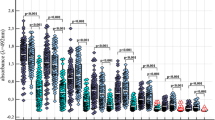Abstract
Pili (or fimbriae) are frequently present on most Escherichia coli strains and they mediate binding to specific receptors. In the present work we used type 1 and P-fimbriated E. coli strains isolated from patients with urinary tract infections to study the antiadhesive effect of some synthetic commercial glucosaminoglycans (GAGs). Quantitative determinations of tritiated bacteria associated with specific receptor-activated resins indicated that displacement by GAGs was more effective in the presence of nonspecific binding. Glucuronilglucosaminoglycan sulfate (Glu-g) and esosaminoglycan sulfate (Eso-g) at a concentration of 10 mg/ml were the most active substances against P-fimbriated E. coli, while galactosaminoglucuronglycan sulfate (Gal-g) behaved as an antiadhesive agent on type 1 fimbriated E. coli also at a lower concentration. The possible use of GAGs for the prophylaxis or treatment of chronic urinary tract infections implies a previous characterization of the piliation phenotype of the clinical isolates.
Similar content being viewed by others
References
Conventi L, Errico G, Mastroprimiano S, D'Elia R, Busolo F (1989) Characterization of Escherichia coli adhesins in patients with symptomatic urinary tract infections. Genitourin Med 65:183
Evans DG, Silver RP, Evans Jr DJ, Chase DG, Gorbach SL (1975) Plasmid-controlled colonization factor associated with virulence in Escherichia coli enterotoxigenic for humans. Infect Immun 12:656
Hanno PM, Ruggieri MR, Levin RM (1984) Comparison of Escherichia coli adherence to the urinary bladder mucosa with the adherence to anion exchange resin. Surg Form 35:637
Hanson MS, Brinton CC Jr (1988) Identification and characterization of Escherichia coli type-1 pilus tip adhesion protein. Nature 332:265
Hoschutzky H, Lottspeich F, Jann K (1989) Isolation and characterization of the α-galactosyl-1,4-α-galactosyl specific adhesin (P adhesin) from fimbriated Escherichia coli. Infect Immun 57:76
Hulygren SJ, Lindberg F, Magusson G, Kihlberg J Tennet JM, Normark S (1989) The PapG adhesin of uropathogenic Escherichia coli contains separate regions for receptor binding and for the incorporation into the pilus. Proc Natl Acad Sci USA 86:4357
Kaack MB, Roberts JA, Baskin G, Patterson GM (1988) Maternal immunization with P-fimbriae for the prevention of neonatal pyelonephritis. Infect Immun 56:1
Klemm P, Orskov I, Orkov F (1982) F7 and type-1 like fimbriae from three Escherichia coli strains isolated from urinary tract infections: protein, chemical and immunological aspects. Infect Immun 36:462
Labigne-Roussel AF, Lark D, Schoonlik G, Falcow S (1984) Cloning and expression of an afimbrial adhesin (AFA-I) responsible for P blood group-independent, mannose-resistant hemaglutination from a pyelonephritic Escherichia coli strain. Infect Immun 46:251
Linberg F, Lund B, Normark J (1986) Gene products specifying adhesion of uropathogenic Escherichia coli are minor components of pili. Proc Soc Natl Acad Sci USA 83:1891
Ofek I, Mayan M (1986) Urinary factors which influence population shift in the expression of mannose specific lectin by K. pneumoniae. In: Proceeding of the IVth International Symposium on pyelonephritis. Goteborg, Sweden: Kompandie Trickeriet-Kallered, vol 63
Parsons CL (1982) Prevention of urinary tract infection by the exogenous glycosaminoglycan sodium pentosanpolysulfate. J Urol 127:167
Parsons CL, Shrom SH, Hanno PM, Mulholland SG (1978) Bladder surface mucin. Examination of possible mechanisms for its antibacterial effect. Invest Urol 16:196
Parsons CL, Pollen JJ, Anwar H, Stauffer C, Schmidt JD (1980) Antibacterial activity of bladder mucin duplicated in the rabbit bladder by exogenous glycosaminoglycan (sodium pentosanpolysulfate). Infect Immun 27:876
Ruggieri MR, Hanno PM, Levin RM (1985) Further characterization adherence to urinary bladder mucosa: comparison with adherence to anion exchange resin. J Urol 134:1019
Ruggieri MR, Levin RM, Hanno PM, Witkowski BA, Gill HS, Steinhardt GE (1988) Defective antiadherence activity of bladder extracts from patients with recurrent urinary tract infection J Urol 140:157
Salit IE, Vavougios J, Hofmann T (1983) Isolation and characterization of Escherichia coli pili from a diverse clinical source. Infect Immun 42:755
Svanborg-Eden C, Hanson LA, Jodal U, Lindberg H, Sohl-Akerhardt A (1976) Variable adherence to normal human urinary tract epithelial cells of Escherichia coli strains associated with various forms of urinary tract infection. Lancet II:490
Author information
Authors and Affiliations
Rights and permissions
About this article
Cite this article
Busolo, F., Francescon, L., Aragona, F. et al. Solid-phase binding of clinical isolates of Escherichia coli expressing different piliation phenotypes. Urol. Res. 22, 399–402 (1995). https://doi.org/10.1007/BF00296884
Received:
Accepted:
Issue Date:
DOI: https://doi.org/10.1007/BF00296884




